Drinking cider in Avilés
Our second day in Asturias and the weather revealed why this area is called the Costa Verde. With such a lush green landscape rain wasn't unexpected so we were prepared, deciding to take the FEVE to Avilés, described as a 'gem of a city' in our Inntravel guide and recommended by Montse, owner of Casona de la Paca. The train took a little less than an hour before pulling into the industrial looking station. A freight train took up the full length of one platform, although everything indicated that it had not moved for a while. Unusually for Spanish rail stations, there was a bridge over the platform so we dawdled awhile peering into the trucks of the freight train to see remnants of mounds of coal grown over with weeds. Luckily, the weather improved a little so we headed out on the suggested trail, walking through tiny Plaza Carbayo where fishermen's guilds used to meet before turning into a bigger street to Iglesia Santo Tomas de Canterbury, named after Thomas Beckett. Following the well drafted notes for the route, we arrived at the Plaza de Abastos, with my favourite thing to explore, the Spanish covered market.
Wandering through these markets is a foodie's dream. Everything looks so fresh and enticing and the weekly shop looks so much more of a social affair. I cannot help but compare it to supermarket shopping in the UK and wonder why we don't have something similar. As well as being able to buy the freshest seasonal produce from local experts, there is also the extremely minimal packaging (so better for everyone) as well as the chance to have a cheeky aperitif before sampling some produce for lunch.
I was already aware of Cabrales, the famous Asturian blue cheese but there were many others to choose from too. Piles of fabes de la Granja (white beans) of differing sizes sat next to mounds of morcilla, chorizo, tocino (bacon) and slabs of fatty shoulder of pork, all necessary ingredients for the hearty local stew fabada asturiana. Shoals of bright eyed fish peered glassily from ice covered tables and trade in octopus, squid and blood red tuna was brisk. Feeling peckish after viewing this culinary wealth we decided to stop for a while, settling at a table in Bar la Escuelina for a couple of café solos, which came with a complimentary plate of tiny sandwiches all for less than €4. A perfect place to people watch, trying to take a discreet peek in the bulging bags of gossiping shoppers and wonder what delights they'll be cooking up later.
With the sun now peeking through the clouds we headed for the shade of Parque de la Ferrera, walking the perimeter before joining some Spanish mums and kids feeding the ducks at the pond, laughing with the crowd as a large carp dislodged a seagull in a sub aquatic attack. Having taken our fill of history, we changed tack, taking the path over an industrial metal bridge cantilevered precariously over the river towards the Centro Niemeyer.
Centro Niemeyer
I'd been warned that this striking feature was the 'Marmite' of the architectural world, you either love it or hate it. It certainly has an incongruous setting with its futuristic and dazzling white structures casting an odd contrast to the city's historical heart. A viewing tower and large undulating dome appear to literally grow from swathes of concrete and it was eerily quiet. We became quite sidetracked in taking photos of the abstract curves against the cloudy sky. Designed by the Brazilian architect Oscar Niemeyer in 2011 the buildings are used as a cultural centre with a large auditorium, cinema and exhibition space. I love that Spain has such contrasts of architecture and is not afraid of placing brave designs next to areas of history.
Inside the auditorium was an exhibition of photographs by Franco Fontana, the Italian landscape photographer. His prints echoed the buildings with their abstract views of clouds, fields and sea and was well worth the €3 entry fee.
Cider drinking in Tierra Astur
Well past midday it was soon time to sample some Asturian cider over lunch. Tierra Astur, a small chain of restaurants specialising in Asturian food seemed the perfect choice. It was packed with shoppers and workers (this is a very un-touristy city, I think we were the only extranjeros). Cider bottle chandeliers hang over cider barrel tables, with larger barrels even forming snug private 'rooms' and sawdust littered the floor. You will be reminded very strongly of Belgo, the chain of Belgian restaurants in London. We were here to sample our first Asturian cider and I'd done my research into the etiquette of cider drinking, this region's most famous product, to avoid any embarrassment.
Asturian cider is flat, like scrumpy and is served in large green bottles. You don't pour your own drink, instead an escanciador (cider pouring waiter) will pour you an inch of cider into a flat bottomed glass from an impossible height (with a very serious expression). This creates a slight fizz and is said to improve the flavour. You then knock back most of the glass in one (so that the fizz doesn't go flat) retaining a small amount to swill out your glass and throw into the sawdust on the floor (this last part is said to refresh the glass). Your escanciador will turn their back to you whilst pouring into the glass to reduce any cider splash-back but expect to come out of the bar smelling vaguely apple-y as bottles are poured all around you. At 6% ABV the cider is fairly strong but looking around absolutely everyone is drinking it, raising their glass to request a refill from the busy waiters.
One thing important to note is that portions are HUGE in Tierra Astur. Honestly, take this advice very seriously, you only need to order for one and share. We learned the hard way, ordering a set menu from the grill only to stare in absolute astonishment as groaning boards of steak, ribs, sausages and pork arrived at our table. More medieval banquet for twenty than lunch for two. They certainly have hearty appetites in Asturias, perhaps its the cider! At €14 a head it was hard to see how they could make a profit and we struggled to eat more than a quarter of the meal, although it was good, the steak in particular. Service was brusque but efficient and no seemed to mind that the turistas could not finish their meal.
Avilés is an interesting city, well worth the excursion and definitely to see the Centro Niemeyer (especially if you can time it with an exhibition). Just remember to go very hungry if you eat at Tierra Astur (or sample a little less at the market).
Following on from my posts from my trip to Asturias, further posts are published on InnTravel's excellent The Slow Lane, inspirational tips and trips for taking life at a slower pace.
A Piper's Dream - following the bagpipe around the streets of Oviedo.
Welcome to Ribadesella - exploring this fantastic coastal town on the edge of the Picos de Europa.
Lunch at Arbidel - celebrating in style at chef Jaime Uz's Michelin starred restaurant.
Wandering through these markets is a foodie's dream. Everything looks so fresh and enticing and the weekly shop looks so much more of a social affair. I cannot help but compare it to supermarket shopping in the UK and wonder why we don't have something similar. As well as being able to buy the freshest seasonal produce from local experts, there is also the extremely minimal packaging (so better for everyone) as well as the chance to have a cheeky aperitif before sampling some produce for lunch.
I was already aware of Cabrales, the famous Asturian blue cheese but there were many others to choose from too. Piles of fabes de la Granja (white beans) of differing sizes sat next to mounds of morcilla, chorizo, tocino (bacon) and slabs of fatty shoulder of pork, all necessary ingredients for the hearty local stew fabada asturiana. Shoals of bright eyed fish peered glassily from ice covered tables and trade in octopus, squid and blood red tuna was brisk. Feeling peckish after viewing this culinary wealth we decided to stop for a while, settling at a table in Bar la Escuelina for a couple of café solos, which came with a complimentary plate of tiny sandwiches all for less than €4. A perfect place to people watch, trying to take a discreet peek in the bulging bags of gossiping shoppers and wonder what delights they'll be cooking up later.
Refreshed by a shot of caffeine we reluctantly moved on, heading up to the sand coloured Plaza España dominated by the flag covered town hall. Following the guide notes we turned left past an 17th century fountain, the Fuente de los Canos de San Francisco, the oldest surviving public water fountain in town. Its six stone heads, faces frozen in perpetual astonishment spew forth clean water into the trough below, an early effort in sanitation.
Here the historical heart of Avilés lies, the beautiful street of Calle Galiana gently curving upwards lined by a Baroque colonnaded walkway. Waiters were busy setting up chairs around cider barrels for the many sidrerías that spill out under these arches. They must have used this street for filming, its the perfect setting for a costume drama, with hardly any evidence of the 21st century, blink and you'll be transported three hundred years into the past. Turning a corner at the top end of the street you'll find a perfectly preserved horreo, El Horreo de Carbayedo, sitting very self consciously slap bang in the middle of the city.
Centro Niemeyer
I'd been warned that this striking feature was the 'Marmite' of the architectural world, you either love it or hate it. It certainly has an incongruous setting with its futuristic and dazzling white structures casting an odd contrast to the city's historical heart. A viewing tower and large undulating dome appear to literally grow from swathes of concrete and it was eerily quiet. We became quite sidetracked in taking photos of the abstract curves against the cloudy sky. Designed by the Brazilian architect Oscar Niemeyer in 2011 the buildings are used as a cultural centre with a large auditorium, cinema and exhibition space. I love that Spain has such contrasts of architecture and is not afraid of placing brave designs next to areas of history.
Inside the auditorium was an exhibition of photographs by Franco Fontana, the Italian landscape photographer. His prints echoed the buildings with their abstract views of clouds, fields and sea and was well worth the €3 entry fee.
Cider drinking in Tierra Astur
Well past midday it was soon time to sample some Asturian cider over lunch. Tierra Astur, a small chain of restaurants specialising in Asturian food seemed the perfect choice. It was packed with shoppers and workers (this is a very un-touristy city, I think we were the only extranjeros). Cider bottle chandeliers hang over cider barrel tables, with larger barrels even forming snug private 'rooms' and sawdust littered the floor. You will be reminded very strongly of Belgo, the chain of Belgian restaurants in London. We were here to sample our first Asturian cider and I'd done my research into the etiquette of cider drinking, this region's most famous product, to avoid any embarrassment.
Asturian cider is flat, like scrumpy and is served in large green bottles. You don't pour your own drink, instead an escanciador (cider pouring waiter) will pour you an inch of cider into a flat bottomed glass from an impossible height (with a very serious expression). This creates a slight fizz and is said to improve the flavour. You then knock back most of the glass in one (so that the fizz doesn't go flat) retaining a small amount to swill out your glass and throw into the sawdust on the floor (this last part is said to refresh the glass). Your escanciador will turn their back to you whilst pouring into the glass to reduce any cider splash-back but expect to come out of the bar smelling vaguely apple-y as bottles are poured all around you. At 6% ABV the cider is fairly strong but looking around absolutely everyone is drinking it, raising their glass to request a refill from the busy waiters.
One thing important to note is that portions are HUGE in Tierra Astur. Honestly, take this advice very seriously, you only need to order for one and share. We learned the hard way, ordering a set menu from the grill only to stare in absolute astonishment as groaning boards of steak, ribs, sausages and pork arrived at our table. More medieval banquet for twenty than lunch for two. They certainly have hearty appetites in Asturias, perhaps its the cider! At €14 a head it was hard to see how they could make a profit and we struggled to eat more than a quarter of the meal, although it was good, the steak in particular. Service was brusque but efficient and no seemed to mind that the turistas could not finish their meal.
Avilés is an interesting city, well worth the excursion and definitely to see the Centro Niemeyer (especially if you can time it with an exhibition). Just remember to go very hungry if you eat at Tierra Astur (or sample a little less at the market).
A Piper's Dream - following the bagpipe around the streets of Oviedo.
Welcome to Ribadesella - exploring this fantastic coastal town on the edge of the Picos de Europa.
Lunch at Arbidel - celebrating in style at chef Jaime Uz's Michelin starred restaurant.



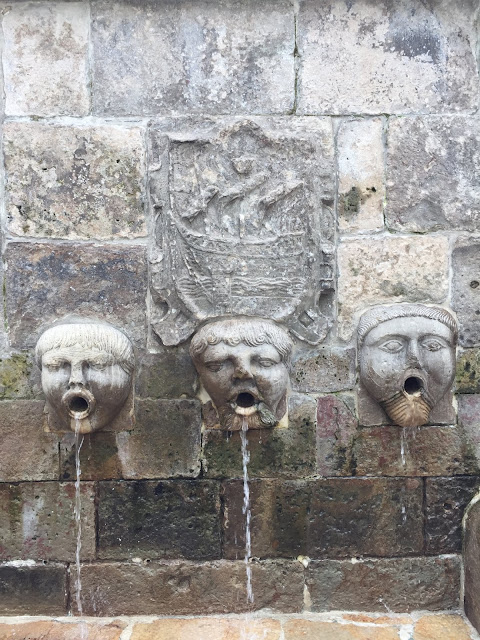
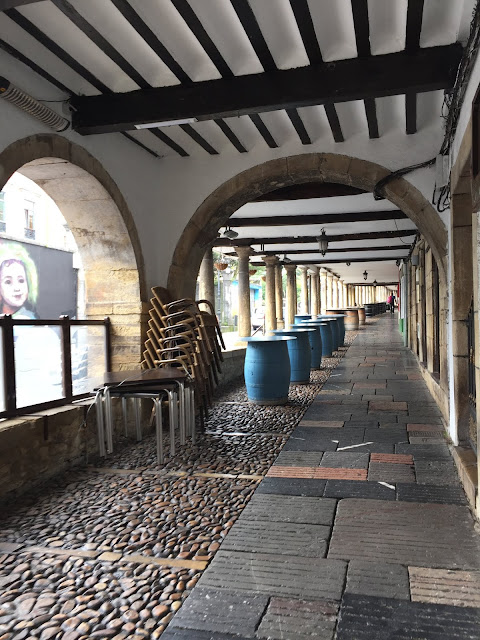
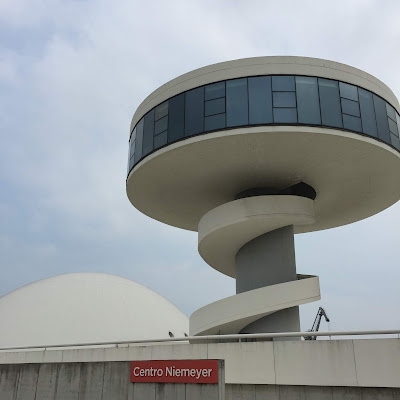
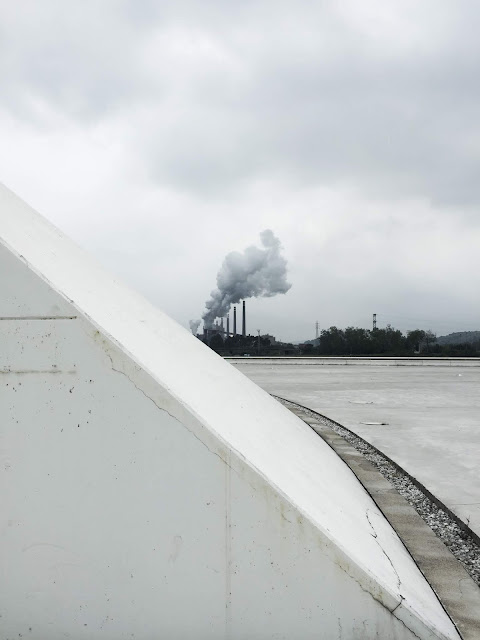
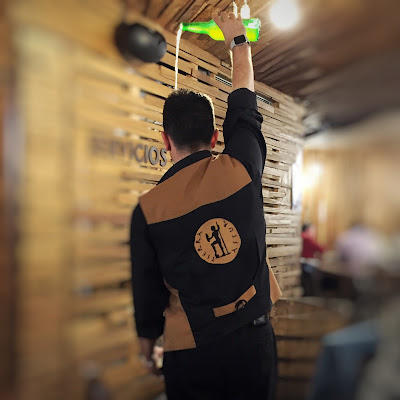






Comments
Post a Comment